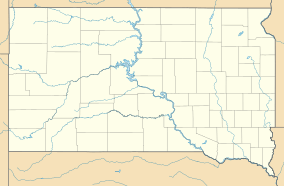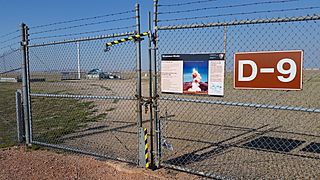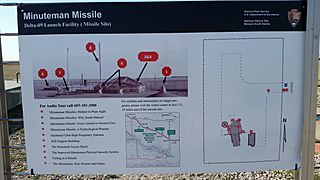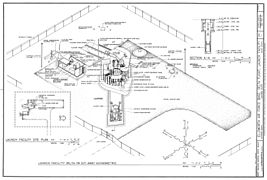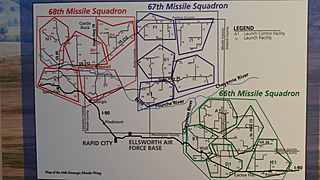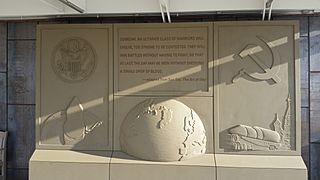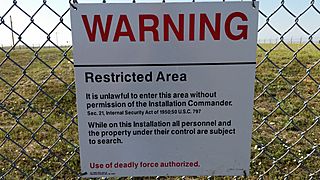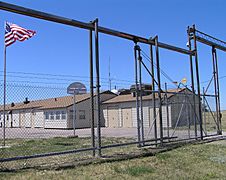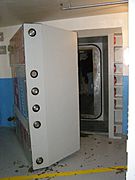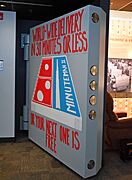Minuteman Missile National Historic Site facts for kids
Quick facts for kids Minuteman Missile National Historic Site |
|
|---|---|
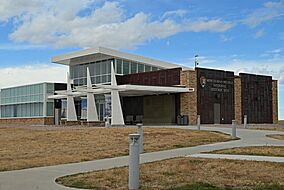
Visitor Center
|
|
| Location | Jackson County and Pennington County, South Dakota, U.S. |
| Nearest city | Wall, South Dakota |
| Area | 43.8 acres (17.7 ha) |
| Established | November 29, 1999 |
| Visitors | 98,908 (in 2020) |
| Governing body | National Park Service |
| Website | Minuteman Missile National Historical Site |
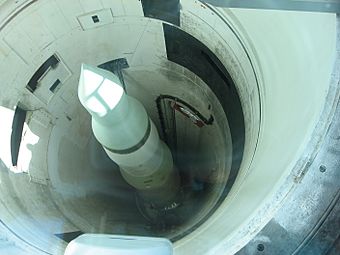
A view of the silo from above
|
|
| Area | 1.6 acres (0.65 ha) |
| NRHP reference No. | 01000275 |
| Added to NRHP | November 29, 1999 |
The Minuteman Missile National Historic Site is a special place in South Dakota. It was created in 1999 near Wall. This site helps us understand an important time in history called the Cold War. It also teaches us about the race to build powerful nuclear weapons. These weapons were called intercontinental ballistic missiles, or ICBMs.
This historic site protects the last complete Minuteman II ICBM system in the United States. These missiles are no longer armed or used for war. You can take tours to see an underground control center. You can also look down into a missile silo. Even today, about 450 newer Minuteman III missiles are still active. They are located at air force bases in Montana, North Dakota, and Wyoming.
Contents
Exploring the Minuteman Missile Site
This national historic site has three main parts. There is a visitor center where you can learn more. It also includes two important sites from the Cold War. One is a launch control center. The other is a missile silo, which is a place where a missile was stored. These sites were once used by the 44th Strategic Missile Wing. This group was based at Ellsworth Air Force Base in South Dakota.
These facilities are the only remaining parts of a huge nuclear missile field. This field once held 150 Minuteman II missiles. It also had 15 launch-control centers. The whole area covered over 13,500 square miles (35,000 km2) of southwestern South Dakota.
What You Can See at the Site
The Minuteman Missile National Historic Site lets you explore two key locations. These are the Delta Nine missile silo and the Delta One launch control facility. Both offer a unique look into the past.
Delta Nine: The Missile Silo
The silo, called Delta Nine (D-09), was built in 1963. It covers about 1.6 acres. It is located near Interstate 90 and about six miles (9.7 km) from Wall, South Dakota. This silo is a deep, underground tube. It is 12 feet (3.7 m) wide and 80 feet (24.4 m) deep. It is made of strong concrete and steel.
Inside, you can see an unarmed missile. The huge, 90-ton cover of the launch tube is partly open. It is welded in place so it cannot move. A glass cover now protects the opening. This lets visitors see the missile safely. It also shows other countries, like Russia, that the site is not active. This helps follow the Strategic Arms Reduction Treaty.
You cannot go underground into the silo. This is because the only way down is a 30 feet (9.1 m) ladder, which is not safe for tours. Instead, you can take a self-guided tour during the day. You call a phone number on your cell phone. Then you walk around the site and listen to descriptions of different spots.
Delta One: The Control Center
The launch control facility, called Delta One (D-01), is about 10.5 miles (16.9 km) away from the silo. It covers about six acres. It is located north of I-90. This site has a building above ground. It used to have a kitchen, sleeping areas, and offices.
Below this building is the actual launch control center. It is buried 31 feet (9.4 m) deep. An elevator connects it to the building above. You can take guided tours underground here. However, only six people can go at a time. This is because the underground control center, called a "capsule," is very small. These tours last about half an hour.
You cannot take self-guided tours at Delta One. The gate around D-01 is always locked. This is just like when it was an active missile control center.
A Look Back: The Cold War Story
This missile complex was one of six in the central United States. It was built to stop the Soviet Union from launching a nuclear attack first. The idea was that if missiles were hidden underground in many places, some would survive any attack. These surviving missiles could then strike back. This would make any country think twice before attacking.
The Minuteman missiles here were ready for action for almost 30 years. Then, in 1991, President George H. W. Bush and Soviet leader Mikhail Gorbachev signed the Strategic Arms Reduction Treaty. This treaty aimed to reduce nuclear weapons. After the treaty, the missiles were removed from their silos. In 1994, the 44th Missile Wing was closed down. All the other missile sites in the area were destroyed, except for D-01 and D-09.
Why This Site is Important Today
D-01 and D-09 were chosen to become a national historic site for a few reasons. They were both close to a main road (Interstate 90). They were also near popular places like Badlands National Park and Mount Rushmore National Memorial. Also, these sites had not been changed much since they were built in the 1960s.
In 2013, the park grew bigger. About 29 acres (12 ha) of land was added to the site. This new land came from the nearby Buffalo Gap National Grassland. It helped make space for a new visitor facility.
Gallery
-
Quote by Sun Tzu
See also
- List of museums in South Dakota
- Ronald Reagan Minuteman Missile State Historic Site
- Titan Missile Museum
- Quebec-One Missile Alert Facility
- Strategic Air and Space Museum – This museum has Minuteman II, Minuteman III, and Titan II missile parts and control systems.
- Strategic missile forces museum in Ukraine – A similar museum in what used to be the Soviet Union.


